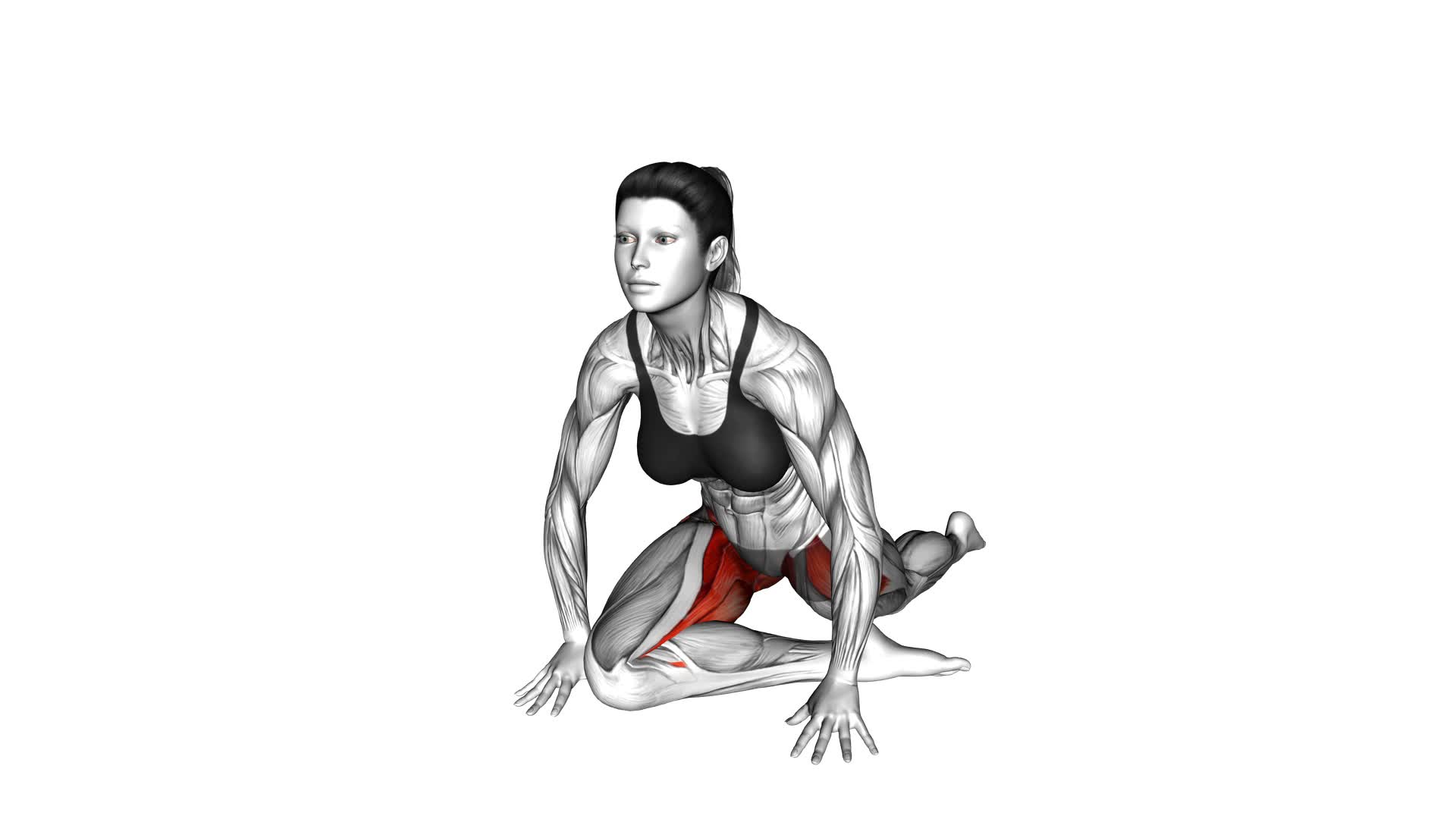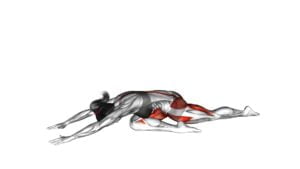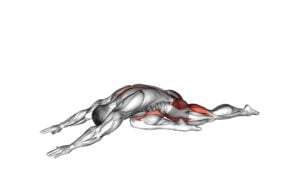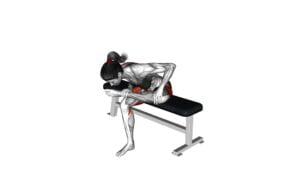Half Pigeon Hip Stretch (female) – Video Exercise Guide & Tips

Are you looking to improve your hip flexibility and relieve tightness? Then the Half Pigeon Hip Stretch is perfect for you!
Watch This Exercise Video
In this video exercise guide, we'll show you the proper form and alignment, modifications for different fitness levels, and common mistakes to avoid.
Plus, we'll give you tips on how to get the most out of the stretch.
Get ready to unlock your hips and feel the benefits of this effective stretch.
Let's dive in!
Key Takeaways
- Improves hip flexibility
- Alleviates lower back pain
- Increases blood flow to the hip area
- Releases tension and tightness in the hips
Benefits of the Half Pigeon Hip Stretch
You can experience several benefits from practicing the Half Pigeon Hip Stretch. This exercise is a great way to improve hip flexibility and open up the hips. By targeting the muscles in the hip area, the Half Pigeon Hip Stretch helps to release tension and tightness in the hips. This can be especially beneficial for those who sit for long periods or engage in activities that require repetitive hip movements, such as running or cycling.
In addition to improving hip flexibility, the Half Pigeon Hip Stretch also helps to increase blood flow to the hip area. This increased blood flow can help to nourish the muscles and promote healing and recovery. It can also help to reduce muscle soreness and stiffness, allowing for better overall mobility.
Another benefit of the Half Pigeon Hip Stretch is its ability to alleviate lower back pain. Tight hips can often contribute to lower back pain, so by stretching and opening up the hips, you can help to relieve any discomfort in the lower back.
Proper Form and Alignment for the Stretch
Achieving proper form and alignment is crucial for maximizing the benefits of the Half Pigeon Hip Stretch. When performing this stretch, it's important to focus on maintaining good hip flexibility and alignment to avoid potential injuries and ensure an effective stretch.
To start, begin in a tabletop position with your hands and knees on the ground. Bring your right knee forward and place it behind your right wrist. Your right foot should be positioned near your left hip. Extend your left leg behind you, keeping it straight and aligned with your hip. Your toes should be pointing straight back.
Next, slowly lower your upper body down towards the ground, resting your forearms and forehead on the mat. Make sure to keep your hips square and level, avoiding any twisting or tilting. You should feel a deep stretch in your right hip and glute area. If you feel any discomfort or strain, it may be necessary to modify the stretch by using props such as blankets or blocks to support your body.
Remember to breathe deeply and relax into the stretch, allowing your body to gradually open up and release tension. Hold the position for about one to two minutes, then slowly release and switch sides.
Modifications and Variations for Different Fitness Levels
To modify the Half Pigeon Hip Stretch for different fitness levels, try incorporating variations that cater to your individual needs and abilities. If you're pregnant, it's important to modify the stretch to ensure the safety of both you and your baby. Instead of bringing your front leg parallel to the front of the mat, you can bring it out to the side to create more space for your belly. This modification will help alleviate any discomfort and pressure on your abdomen.
For individuals with tight hips, there are several variations that can be incorporated to gradually increase flexibility. You can start by using props such as blocks or blankets to support your hips, allowing for a gentler stretch. As your flexibility improves, you can gradually reduce the height of the props until you're able to perform the stretch without any assistance. Additionally, you can modify the stretch by keeping your back knee bent instead of straightening it fully. This will help reduce the intensity of the stretch and make it more accessible for those with tight hips.
Remember to listen to your body and go at your own pace. Modifications and variations are meant to help you adapt the stretch to your individual needs and abilities. Always consult with a qualified fitness professional or healthcare provider before attempting any new exercise, especially during pregnancy.
Common Mistakes to Avoid During the Exercise
To ensure you get the most out of the Half Pigeon Hip Stretch, it's important to focus on proper hip alignment and engaging your core muscles.
One common mistake to avoid is allowing the hip of the bent leg to roll outwards, which can put strain on the knee and compromise the effectiveness of the stretch.
Additionally, be mindful not to collapse your chest or round your back, as this can limit the stretch and potentially cause discomfort.
Proper Hip Alignment
Make sure you maintain proper hip alignment during the Half Pigeon Hip Stretch to avoid common mistakes. Proper hip alignment is crucial for maximizing the benefits of this exercise and preventing any potential injuries. Here are some tips to ensure you have the correct hip alignment:
- Square your hips: Align your hips so they're facing forward and parallel to the front of your mat. This helps to target the hip flexors and glutes more effectively.
- Keep your back straight: Avoid rounding your back by keeping it straight throughout the stretch. This helps to maintain proper alignment and prevents strain on the lower back.
- Engage your core: Activate your core muscles to support your spine and maintain stability during the stretch.
- Listen to your body: Pay attention to any discomfort or pain in your hips and adjust the stretch accordingly. Everyone's hip mobility and flexibility are different, so it's important to find the right position for you.
Engaging Core Muscles
Maintain proper hip alignment by engaging your core muscles during the Half Pigeon Hip Stretch to avoid common mistakes.
Engaging your core muscles is essential for maintaining stability and balance throughout the exercise. By activating your core, you create a strong center of support that helps protect your lower back and improves your overall posture.
To engage your core, focus on drawing your navel towards your spine and tightening your abdominal muscles. Remember to breathe deeply and evenly throughout the stretch, using your breath to help deepen the stretch and release tension.
Tips for Getting the Most Out of the Stretch
Are you properly positioning your body during the Half Pigeon Hip Stretch to maximize its benefits? This popular yoga stretch is great for improving flexibility and preventing hip injuries, but there are a few tips to keep in mind to ensure you're getting the most out of the stretch.
Here are some tips for getting the most out of the Half Pigeon Hip Stretch:
- Align your hips: Make sure your front leg is parallel to the front edge of your mat, and your back leg is extended straight behind you. This alignment will help you target the hip flexors and outer hip muscles effectively.
- Engage your core: By engaging your core muscles, you can stabilize your body and deepen the stretch. Draw your navel in towards your spine and maintain a strong core throughout the stretch.
- Relax your upper body: While it's important to engage your core, remember to relax your upper body and avoid tension in your shoulders and neck. Focus on allowing your hips to open and release any tension in the hips and glutes.
- Breathe deeply: Deep breathing can help you relax into the stretch and allow for a greater range of motion. Inhale deeply as you lengthen your spine, and exhale as you deepen the stretch.
Safety Precautions and Preparations Before Attempting the Stretch
Before attempting the half pigeon hip stretch, it's important to take the necessary safety precautions and preparations.
Start by properly warming up your body with dynamic stretches and movements to increase blood flow and flexibility.
Additionally, make sure you have the appropriate equipment and props, such as a yoga mat and a bolster or blanket, to support and protect your body during the stretch.
Proper Warm-Up Techniques
To ensure a safe and effective warm-up for the Half Pigeon Hip Stretch, start by incorporating specific dynamic movements into your routine. Dynamic stretching involves moving your muscles and joints through a full range of motion, preparing your body for the upcoming stretch. Here are some important warm-up techniques to consider:
- Leg swings: Stand next to a wall and swing one leg forward and backward, then side to side. This helps to loosen up your hip flexors and increase mobility.
- Hip circles: Stand with your feet shoulder-width apart and make circular movements with your hips. This helps to warm up the hip joints and improve flexibility.
- Walking lunges: Take a step forward with one leg and lower your body into a lunge position. Alternate legs as you walk forward. This warms up the muscles in your legs and hips.
- High knees: March in place while lifting your knees up towards your chest as high as possible. This activates your hip flexors and prepares them for the stretch.
Equipment and Props Needed
Continuing from the previous subtopic, let's now explore what equipment and props you'll need to ensure safety and preparation before attempting the Half Pigeon Hip Stretch.
This stretch requires minimal equipment, making it accessible to most individuals. You'll need a yoga mat or a soft surface to provide cushioning and support for your body during the stretch.
Additionally, using a yoga block or a folded blanket can help modify the stretch if you have any injuries or limitations. These props can provide extra support and reduce the intensity of the stretch, allowing you to perform it safely and comfortably.
Frequently Asked Questions
How Long Should I Hold the Half Pigeon Hip Stretch in Order to See Results?
To see results from the half pigeon hip stretch, it's important to hold the pose for an appropriate length of time. For beginners, start with 30 seconds and gradually work your way up to 1-2 minutes.
Remember to listen to your body and go at your own pace.
If you want to spice up your routine, try different variations of the half pigeon hip stretch to target different muscles and improve flexibility.
Can the Half Pigeon Hip Stretch Help Alleviate Lower Back Pain?
The half pigeon hip stretch is one of the best stretches for lower back pain.
It can help alleviate discomfort by targeting the muscles in your hips and lower back.
By incorporating this stretch into your routine, you can experience the benefits of improved flexibility and reduced tension in these areas.
To see results, it's recommended to hold the stretch for about 30 seconds on each side.
Is It Normal to Feel Discomfort or Tightness in the Outer Hip During the Stretch?
Feeling discomfort or tightness in the outer hip during the stretch is normal. This may indicate tightness or tension in that area. It's important to listen to your body and not push yourself too far.
If the discomfort becomes too intense, you can try modifying the stretch by using props like blocks or blankets for support.
Additionally, incorporating other hip-opening stretches like the butterfly stretch or the seated forward fold can help alleviate tightness in the outer hip.
Can I Perform the Half Pigeon Hip Stretch if I Have Knee or Hip Injuries?
Yes, you can perform the half pigeon hip stretch even if you have knee or hip injuries.
However, it's important to modify the pose to avoid further discomfort or injury.
Consider using props such as blankets or blocks to support your body and reduce strain on the affected areas.
Listen to your body and only go as far as feels comfortable.
If needed, consult with a healthcare professional or a qualified yoga instructor for specific modifications that suit your condition.
Are There Any Specific Breathing Techniques I Should Follow While Doing the Half Pigeon Hip Stretch?
When doing the half pigeon hip stretch, it's important to focus on your breath. Incorporating specific breathing techniques can enhance the benefits of this yoga pose.
By taking slow, deep breaths, you can relax your body and deepen the stretch. As you inhale, imagine the breath reaching into the tight areas of your hips. And as you exhale, allow any tension or discomfort to release.
Remember to listen to your body and adjust the stretch accordingly.
Conclusion
In conclusion, the half pigeon hip stretch is a beneficial exercise for improving hip flexibility and relieving tension in the muscles. By maintaining proper form and alignment, modifying the stretch to suit individual fitness levels, and avoiding common mistakes, one can maximize the benefits of this exercise.
It's important to follow safety precautions and prepare adequately before attempting the stretch to prevent any injuries. Incorporating this stretch into your fitness routine can help enhance your overall flexibility and mobility.

Author
Years ago, the spark of my life’s passion ignited in my mind the moment I stepped into the local gym for the first time. The inaugural bead of perspiration, the initial endeavor, the very first surge of endorphins, and a sense of pride that washed over me post-workout marked the beginning of my deep-seated interest in strength sports, fitness, and sports nutrition. This very curiosity blossomed rapidly into a profound fascination, propelling me to earn a Master’s degree in Physical Education from the Academy of Physical Education in Krakow, followed by a Sports Manager diploma from the Jagiellonian University. My journey of growth led me to gain more specialized qualifications, such as being a certified personal trainer with a focus on sports dietetics, a lifeguard, and an instructor for wellness and corrective gymnastics. Theoretical knowledge paired seamlessly with practical experience, reinforcing my belief that the transformation of individuals under my guidance was also a reflection of my personal growth. This belief holds true even today. Each day, I strive to push the boundaries and explore new realms. These realms gently elevate me to greater heights. The unique combination of passion for my field and the continuous quest for growth fuels my drive to break new ground.







